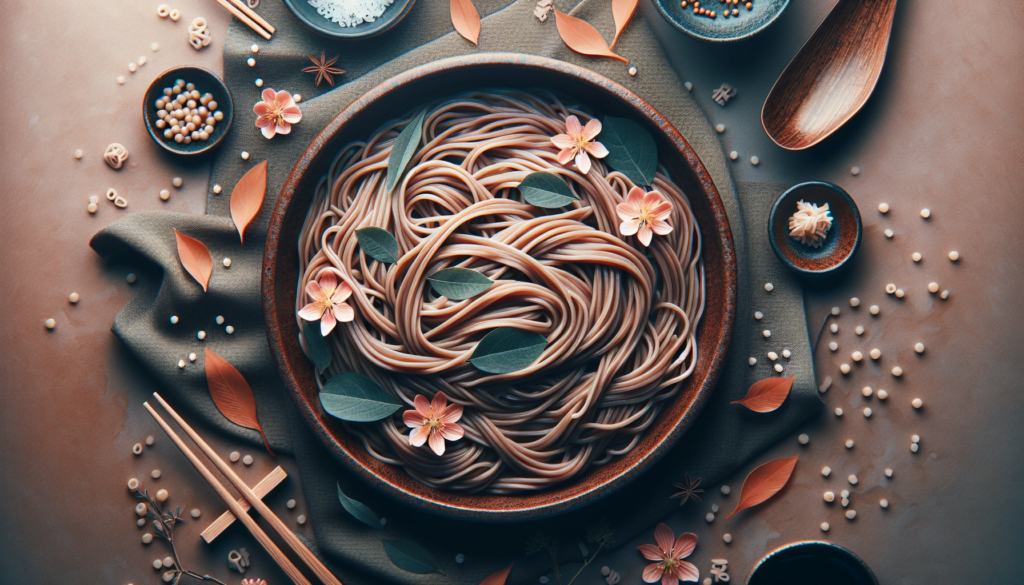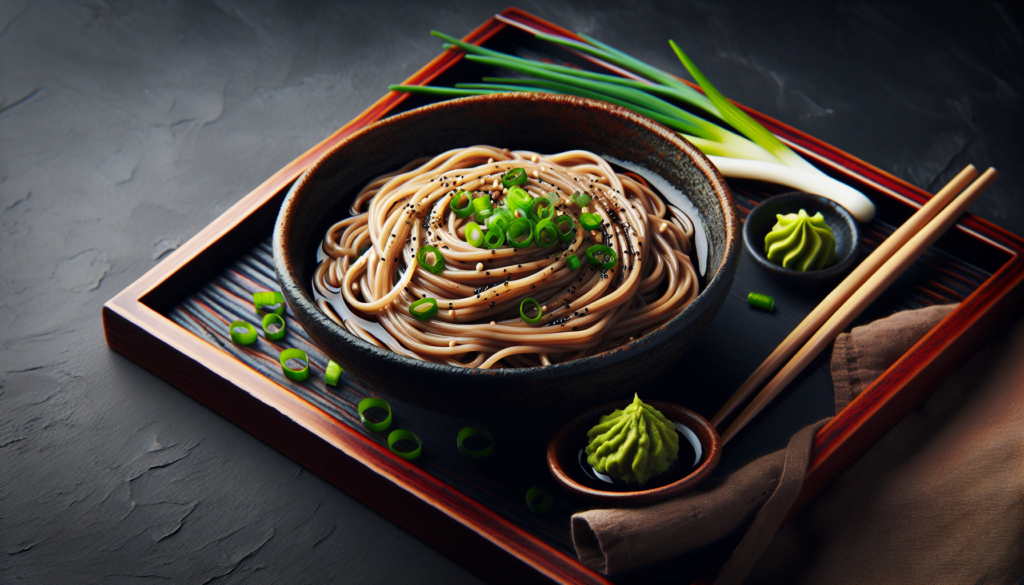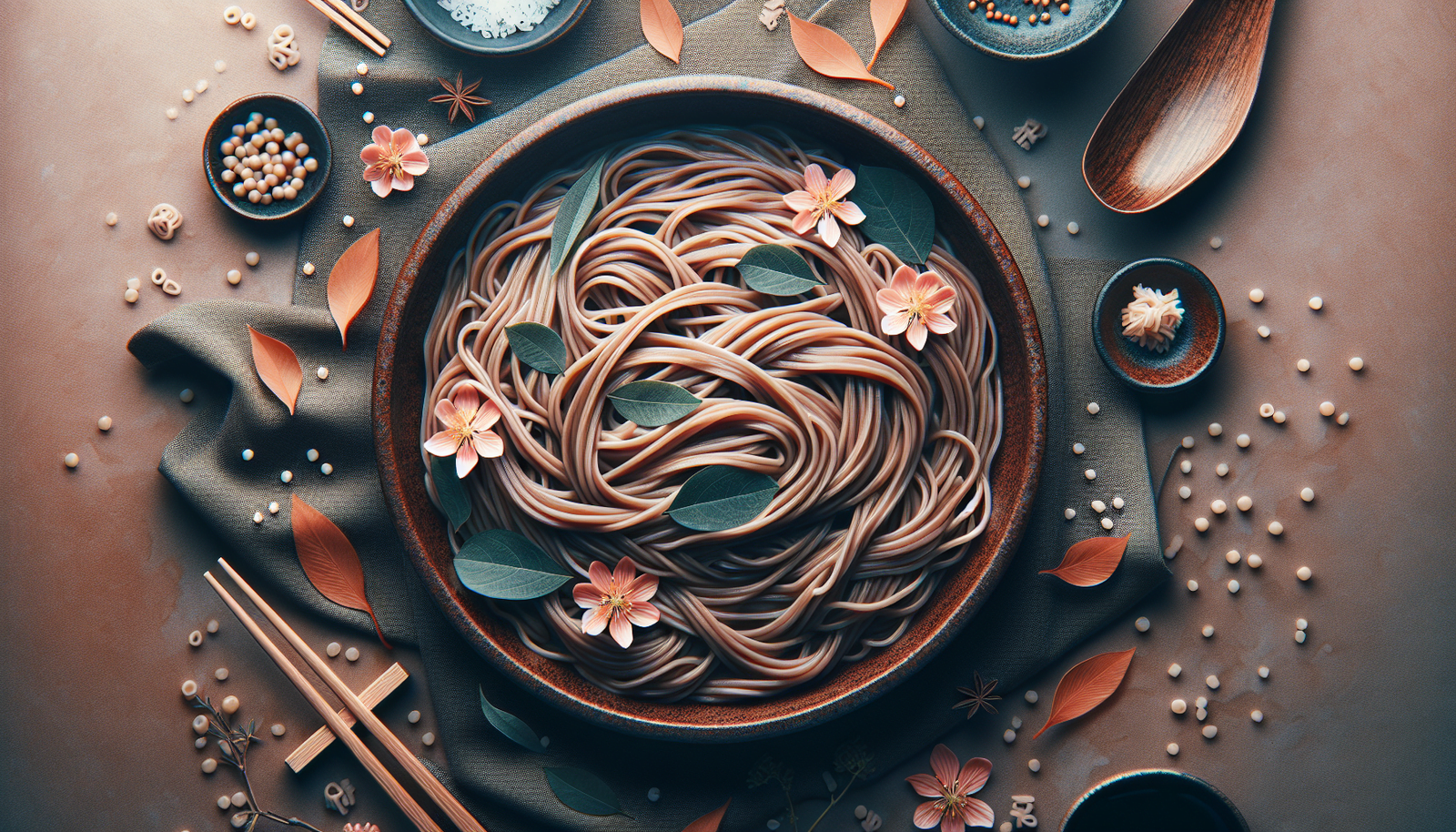I recently discovered the delightful world of Soba noodles and let me tell you, it’s been nothing short of a culinary revelation. These thin, chewy noodles made from buckwheat have quickly become my go-to comfort food. From their unique texture to their earthy flavor, every bite of these Japanese delicacies is a treat for the taste buds. Whether enjoyed hot in a steaming bowl of soup or cold in a refreshing salad, soba noodles have definitely earned a permanent spot in my kitchen. So, join me on this culinary adventure as we explore the wonders of soba noodles and learn how to cook them to perfection. Trust me, you’ll be hooked too!
History of Soba Noodles

Origin of soba noodles
Soba noodles have a long and fascinating history that can be traced back to ancient times. It is believed that soba noodles originated in China over 1300 years ago and were eventually brought to Japan sometime during the 8th century. The word “soba” actually means buckwheat in Japanese, which is the main ingredient used to make these delicious noodles.
Introduction to soba noodles in Japan
Once soba noodles made their way to Japan, they quickly gained popularity as a staple in the Japanese diet. Soba noodles were initially considered a luxury food, only consumed by the aristocracy and the wealthy. However, over time, their popularity grew and they became more accessible to the general population. Today, soba noodles are a beloved dish enjoyed by people of all ages and backgrounds in Japan.
Soba noodles in the modern era
In the modern era, soba noodles continue to be a cherished part of Japanese cuisine. They are widely available in restaurants, supermarkets, and even convenience stores throughout the country. Soba noodles are often enjoyed both hot and cold, and they can be served in a variety of dishes ranging from simple noodle soups to elaborate stir-fries. They have also gained international recognition, with soba noodle restaurants popping up in cities around the world.
Types of Soba Noodles
Buckwheat soba noodles
Buckwheat soba noodles are the most traditional type of soba noodles and are made primarily from buckwheat flour. These noodles have a distinctive nutty flavor and a slightly chewy texture. Buckwheat soba noodles are typically light brown or grayish in color and can be enjoyed both hot and cold.
Whole wheat soba noodles
Whole wheat soba noodles are made from a combination of buckwheat flour and wheat flour. These noodles have a slightly heartier flavor and a smoother texture compared to buckwheat soba noodles. They are often a popular choice among those who prefer a milder taste and a softer bite.
Green tea soba noodles
Green tea soba noodles, also known as matcha soba noodles, are infused with powdered green tea during the noodle-making process. These noodles have a vibrant green color and a subtle earthy taste. Green tea soba noodles offer a unique twist on the traditional soba noodle experience and are a favorite among tea lovers.
Health Benefits of Soba Noodles
Nutritional value of soba noodles
Soba noodles are not only delicious, but they also offer a range of health benefits. They are a good source of complex carbohydrates, which provide sustained energy throughout the day. Soba noodles also contain fiber, which aids in digestion and helps maintain a healthy weight. Additionally, they are packed with essential minerals such as magnesium, zinc, and iron.
Gluten-free and low in calories
One of the significant advantages of soba noodles is that they are naturally gluten-free, making them an excellent option for individuals with gluten sensitivities or celiac disease. Moreover, soba noodles are relatively low in calories compared to other types of noodles, making them a popular choice among those looking to maintain a healthy weight or follow a balanced diet.
Rich in vitamins and minerals
Soba noodles are a good source of B vitamins, particularly thiamine and riboflavin, which play a vital role in maintaining overall health. They also contain antioxidants such as rutin, which supports cardiovascular health and helps protect against oxidative stress. Additionally, soba noodles provide essential minerals like manganese and magnesium, which are crucial for various bodily functions.
Cooking Soba Noodles
Choosing the right soba noodles
When it comes to choosing soba noodles, there are a few things to keep in mind. First and foremost, opt for high-quality noodles made from 100% buckwheat or a combination of buckwheat and wheat flour. Look for noodles that have a fresh, slightly nutty aroma. It’s also essential to check the cooking instructions on the packaging to ensure you cook them properly.
Boiling soba noodles
Boiling soba noodles is a straightforward process. Start by bringing a pot of water to a rolling boil and add a pinch of salt. Carefully add the soba noodles to the boiling water and gently stir to prevent them from sticking together. Cook the noodles for the recommended time, usually around 5-7 minutes, or until they are al dente. Once cooked, drain the noodles and rinse them under cold water to remove any excess starch.
Cold vs. hot soba noodles
Soba noodles can be enjoyed both hot and cold, depending on personal preference or the dish being prepared. Cold soba noodles are typically prepared by rinsing cooked noodles under cold water and serving them either on a bamboo mat or in a chilled dipping sauce called tsuyu. Hot soba noodles, on the other hand, are often served in a flavorful broth called dashi and topped with various ingredients such as green onions, tempura, or nori.
Serving Soba Noodles

Traditional soba noodle presentations
In Japan, soba noodles are often presented in a traditional and aesthetically pleasing manner. One of the most well-known presentations is called “zaru soba,” where the noodles are placed on a bamboo mat called a zaru and served with a dipping sauce and various toppings. Another popular presentation is “kitsune soba,” where the noodles are served in a hot broth with fried tofu (known as kitsune) on top.
Soba noodle accompaniments
Soba noodles are typically served with a variety of accompaniments to enhance the overall dining experience. Common toppings include sliced green onions, grated daikon radish, nori seaweed, and tempura. Additionally, condiments such as wasabi, soy sauce, and ponzu sauce are often provided to add extra flavor to the noodles.
Soba noodles in different cuisines
While soba noodles are deeply rooted in Japanese cuisine, their versatility allows them to be incorporated into various international dishes. In fusion cuisine, soba noodles are often used as a base for salads, stir-fries, and even noodle bowls. They can be paired with a wide range of ingredients, both traditional and non-traditional, to create unique flavor combinations that cater to different tastes and preferences.
Popular Soba Noodle Dishes
Zaru soba
Zaru soba is a classic Japanese dish where cold soba noodles are served on a bamboo mat (zaru) and accompanied by a dipping sauce (tsuyu). The noodles are typically garnished with sliced green onions and grated daikon radish, adding crunch and freshness to each bite. Zaru soba is a refreshing and light option, especially in the warmer months.
Kitsune soba
Kitsune soba is another beloved soba noodle dish that consists of hot soba noodles served in a flavorful broth and topped with fried tofu (kitsune). The sweet and savory flavors of the broth complement the nuttiness of the soba noodles, creating a harmonious combination. Kitsune soba is often enjoyed as a comforting meal during the colder seasons.
Tempura soba
Tempura soba is a popular dish that combines the crispy and delicate flavors of tempura with the heartiness of soba noodles. In this dish, hot soba noodles are served in a flavorful broth and topped with assorted tempura, including shrimp, vegetables, and seafood. The contrast between the crunchy tempura and the chewy noodles makes for a satisfying and delicious meal.
Soba Noodle Variations
Yakisoba
Yakisoba is a stir-fried noodle dish that features soba noodles cooked with various vegetables, meat, and a tangy sauce. Despite its name, yakisoba does not actually contain soba noodles made from buckwheat but instead uses wheat-based noodles. This dish is commonly found at street food stalls in Japan and is a favorite among locals and tourists alike.
Chilled soba noodle salad
Chilled soba noodle salad is a refreshing and nutritious dish that showcases soba noodles as the star ingredient. The cooked soba noodles are tossed with crisp vegetables, such as cucumber, carrots, and bell peppers, and dressed with a tangy sesame-based dressing. This salad can be enjoyed as a light lunch or as a side dish with grilled meats or seafood.
Soba noodle stir-fry
Soba noodle stir-fry is a quick and easy dish that incorporates the flavors of Asia into a delicious and satisfying meal. In this dish, soba noodles are stir-fried with an assortment of vegetables, protein of choice, and a savory sauce. The result is a flavorful and healthy stir-fry that can be customized to suit individual tastes and dietary preferences.
Cultural Significance of Soba Noodles
Soba noodles in Japanese culture
Soba noodles hold a significant place in Japanese culture and are often associated with longevity and good fortune. It is customary to eat soba noodles on New Year’s Eve, a tradition known as “toshikoshi soba,” which symbolizes letting go of the hardships of the past year and embracing new beginnings. Soba noodles are also a common choice for celebratory meals and special occasions.
Soba noodle festivals
Throughout Japan, soba noodle festivals are held to celebrate and showcase the art of soba noodle making. These festivals often feature various stalls and demonstrations where visitors can learn about the process of making soba noodles. Soba noodle competitions are also held, highlighting the skill and craftsmanship of soba noodle chefs.
Soba noodle etiquette
Eating soba noodles in Japan comes with its own set of etiquette. It is customary to slurp the noodles loudly while eating, as it is believed to enhance the flavors and show appreciation for the meal. Additionally, it is considered good manners to finish the entire serving of noodles, as leaving any behind may be seen as wasteful.
Soba Noodles in the Western World
Rise in popularity of soba noodles
In recent years, soba noodles have gained popularity in the Western world, thanks to their unique taste and nutritional benefits. Many people are drawn to the nutty flavor and versatility of soba noodles, making them a popular choice for those seeking alternative options to traditional wheat-based pasta or noodles. The rise in popularity of Japanese cuisine as a whole has also contributed to the increased demand for soba noodles.
Soba noodles in fusion cuisine
Soba noodles have found their way into fusion cuisine, where they are often used as a substitute for other types of noodles, such as spaghetti or udon. Chefs worldwide have embraced the use of soba noodles in creative and innovative ways, incorporating them into dishes that blend flavors and techniques from different culinary traditions.
Soba noodle availability
Thanks to the growing popularity of soba noodles, they are becoming more readily available in supermarkets and specialty stores outside of Japan. Many health food stores and Asian markets now stock a variety of soba noodles, including traditional buckwheat soba noodles, whole wheat soba noodles, and even green tea soba noodles. This accessibility allows individuals from different cultural backgrounds to experiment with and enjoy the flavors of soba noodles.
Conclusion
Soba noodles have a rich history and a multitude of variations that have captivated people both in Japan and around the world. With their unique flavors, nutritional benefits, and versatility in various dishes, it’s no wonder why soba noodles have remained a beloved staple in Japanese cuisine for centuries. Whether enjoyed in a traditional presentation or as part of a modern fusion creation, soba noodles continue to captivate our palates and delight food enthusiasts. So the next time you cook soba noodles, take a moment to appreciate the art and history behind this humble yet remarkable dish.


